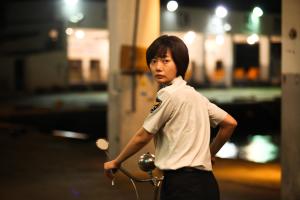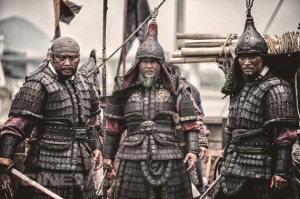By Chris Neilan.
The 19th Busan International Film Festival was, as ever, an unrivalled showground for Asian filmmaking talent. A handsome 312 films were screened this year (up from 299 last year) from 79 countries including efforts from Kyrgyzstan, Kurdistan, Iraq, Bangladesh and Nepal as well as the usual heavyweight entrants from Asian cinema’s tiger industries: Japan, China, Korea, and to a lesser extent Taiwan.
The major prize section at Busan, the New Currents award, is open only to first or second-time Asian directors, with awards given to two outstanding films and designed to highlight upcoming talent and encourage evolution in Asian cinema. Last year awards went to Korean and Mongolian productions dealing with intolerance and misogyny (Ahn Seon-kyoung’s outstandingly bleak Pascha) and rural-urban migratory issues (Byamba Sakhya’s simple but effective Remote Control). This year’s New Currents section boasted several strong entrants, including Indian indie helmer Partho Sen-Gupta’s expressionist psycho-drama Sunrise, and Chinese newcomer Li Xiaofeng’s delicate coming-of-age drama Nezha. But the awards went to Korean production End Of Winter (directed by Kim Daehwan), a deconstruction of tensions in the contemporary Korean family, and Iranian production 13 (directed by Hooman Seyedi), which depicts the adolescent struggles of a 13 year old boy. The prize money, a relatively paltry $30,000 each, is meant to assist in the development of the filmmakers’ next projects. The festival’s A Window On Asian Cinema and Korean Cinema Today sections show the effectiveness of this tactic, with many former New Currents competitors returning with new works.
But what to take away from Busan this year? How to make sense of it all? Where lies the significance of an event like Busan? It was an event in which low budget independent features highlighting socio-political issues and the struggles of the individual within the system were screened alongside big budget box office conquering behemoths revelling in historic conflicts and the unreconstructed elements of nationalism. A festival in the continent which boasts the world’s widest wealth gaps, the poorest poor and the richest rich, in which zero budget productions from developing nations rubbed shoulders with works of formal mercurialism from world heritage masters. A festival which emerged inexorably from the Asian continent and, like a child bearing it’s mother’s beguiling eyes and father’s crooked teeth, projected the continent’s own issues back at it, writ large on silver screen, digitally projected, a 312-part Asian jigsaw.
Socio-Politics
The indie Korean productions which flourish at Busan tend to explore socio-political issues, of which Korea has many: it has the third highest suicide rate in the world, due in no small part to the insane schooling hours suffered by its youths (it’s not uncommon for high schoolers to begin studying at 7am and finish at after-school academies later than 10pm), it has the world’s largest gender pay gap, and a recent UN visit uncovered significant issues surrouding race. These issues were in part raised by two notable productions: July Jung’s A Girl At My Door and Shim Sungbo’s Haemoo.
A Girl At My Door’s protagonist is a troubled female police chief relocated from Seoul to a rural posting where she is confronted with the unreconstructed local inhabitants, their received views on women and propensity for casual domestic violence. She discovers a teen girl being savagely beaten by her father and grandmother, attempts to protect the girl and becomes a de facto mother figure for her, but when doubts are raised about her sexuality ugly rumours begin to spread, and Korean attitudes to homosexuality are called into question. It’s a gripping and emotionally raw feminist crime-drama narrative, carried by an excellent central performance from Bae Doona as the morally strong but emotionally strung out police chief, and well worth the attention of international audiences.
Haemoo is a different beast altogether. Directed by Shim Sungbo, a chief collaborator of Snowpierecer helmer Bong Joon-ho, and co-written by Shim and Bong, Haemoo (translated as Sea Mist) is set in 1997 in the midst of the IMF crisis which hobbled Korea’s flourishing economy, and centres on a fishing trawler whose captain decides to smuggle Korean-Chinese immigrants in an attempt to solve his financial problems. His crew is dominated by the kind of unreconstructed soju-and-barbecue guzzling nationalistic Korean males who usually signify upcoming tragedy, and indeed when their consignment of Korean-Chinese board the tiny trawler in an outstandingly tense sequence the narrative heads quickly towards calamity. Pivoting on an extremely powerful narrative event and boasting several gripping sequences, Haemoo is suspenseful, atmospheric and highly engaging until it descends into genre ticks and slight silliness in its final movement. But it’s significance lies in the way it plums quotidian race and gender issues for its heightened genre thrills, exploding the toxic elements of its characters’ attitudes to their terrible corollories rather than addressing them in dialogue or more obviously textual conflict. Both Haemoo and A Girl At My Door demonstrate the narrative proficiency of Korea’s screenwriters, the formal skills of their promising upcoming directors, and the willingness of filmmakers to address the sociopolitical issues which underpin the economic boom of this small but powerful nation.
Iraqi Kurdistan
At last year’s BIFF a Mongolian production won a major award (Byamba Sakhya’s previously mentioned Remote Control). This year Iraqi Kurdistan made a powerful impression on the festival with two extremely well realised and highly proficient features. Batin Ghobadi‘s Mardan centres around the beleagured figure of Kak Mardan, a peshmerga (member of the armed forces of Kurdistan, literally translating as ‘those who confront death’, and functioning in this narrative much like a police detective), a haunted man ruined by guilt and trauma whose attempts to track down a local Kurdish woman’s missing husband are beset by tragedy, secrecy and his own demons. With a slow, byzantine, sometimes obtuse narrative that gradually gives up great releases of realisation as timelines and experiences shift, Mardan is not a perfect film, not always engaging and sometimes too oblique to decipher, but it boasts by far the most startling photography in the festival. And this is not an insignificant point. Most features from the minnow nations showcase interesting ideas and occassionally brilliant moments, but fail at the photographic level and at the level of narrative construction. Mardan’s visions of the rugged green mountains of Iraqi Kurdistan and of its protagonist’s fatalistic troubles are genuinely miraculous, and hold the attention even when the sophisticated narrative is too coy. Ultimately the weight carried by these extraoridinary images coupled with the oblique, inward-looking story of a place and a people stumbling toward stability but haunted by the lingering imprint of previous terrors seems to discover a powerful significance.
Mardan’s star, Hossein Hussan, a rumpled sparkling-eyed greying figue of gentle masculinity, also stars in Memories On Stone, a Kurdish/Iraqi/German co-production in which a Kurdish film crew encounter difficulty after difficulty as they try to produce a feature film about the Anfal campaign, Saddam Hussein’s Ba’athist slaughter of Kurds and other minority groups between 1986-1989 which killed as many as 182,000 people and is officially recognised as genocide. Engaging and illuminating from start to poignant finish, Shawkat Amin Korki’s film deals with cultural issues and the resonating sadness of an oppressed people, managing to inject moments of comedy and tragedy into a seemingly simple film-crew-struggling-against-the-odds narrative. Hossein Hussan does exemplary work in both films.
Chinese and Japanese Proficiency
China’s roaring, fossil fuel guzzling economy has produced a powerful film industry replete with master directors, not to mention a market which western companies are desperate to bust into, and the power of the Chinese cinema machine was well displayed at Busan. Few nations do period-set slyly political epics like China, and Busan audiences were treated to several films in this vein from such notables as Zhang Yimou (Coming Home) and newly crowned Asian Filmmaker of the Year Ann Hui (The Golden Era). But the more significant Chinese work was Diao Yinan’s Black Coal, Thin Ice, winner of the Golden Bear at this year’s Berlin Film Festival. A decade-spanning Chinese noir in which an uncouth detective pursues an apparently innocent woman whose men tend to end up dead, Black Coal, Thin Ice boasts a febrile, insidious crime narrative dealing with fuel dependency and the destructive force of China’s industrio-economic march. It’s a grim and portentous work, unsimplified, unsettling, the Chinese Chinatown, in which genre cues have been deleted and replaced by ominous realism.
Elsewhere, Chinese debut director Li Xiaofeng impressed with Nezha, a coming-of-age drama about two adolescent girls finding solace in their friendship amidst the suffocating pressures felt by China’s young middle class. Xiaolu immediately bonds with troubled A-student Xiaobing when she starts a new school, but as the two girls age Xiaobing’s troubles lead her down a lonely trajectory away from her more settled friend. Formally impressive, Nezha is a swallowed, subtle, even repressed story (there’s the vaguest hint of something more than friendship between the girls) levened by flashes of emotion, mirroring the experience of its troubled young protagonist. It’s authentic, moving, and beautifully lensed, if a little slow.
Slowness on the other hand is not a problem for Japanese lunatic auteur Sono Sion’s latest anomaly, the hip-hop gang war musical Tokyo Tribe. Set in a semi-dystopian neon-hued Tokyo in which the city’s regions are run by a collection of gangs, all of whom rap to camera throughout and boast their own Walter Hill-esque uniforms and identities, the narrative (sprawling and unfocused as Sono’s narratives usually are) follows good guy Kai and bombastic lunatic bad guys Mera and Buppa as the nefarious Buppa plots a city-wide take over, forcing the less bananas gangs to join forces against them, culminating in a nutso mass battle and various other wildly entertaining insanities. Mera is a bleached blonde, man-thong wearing katana prodigy who prowls around semi-nude and obsesses over penis size, whilst his westernized Elvis-via-Tony-Soprano-via-manga-villain boss Buppa eats dinner with a large green dildo close at hand, growling bassily and pawing his concubines. These impressivley bonkers bad guys seems like grotesque deconstructions of Japanese machismo, but Sono’s gender politics are hard to read. He likes strong female characters, but not as much as he likes upskirt close-ups as they’re high-kicking, or lacivious zooms into their naked breasts. He also falls back on the lamentable east Asian trope of depicting black people as scary: the one black character in this hip-hop musical is characterised by his strength and size and fear factor, and comments about the size of his manhood tip over into dumb-dumb racism. The overall impression though is of an arch-prankster, a genre blender playing with pop iconography, an over-excited boy getting carried away with playing and forgetting about the effect his play might have. It’s hard to get too excited about his work whilst these blemishes remain, and as ever his moments are more effective than his narratives as a whole – but what moments. Quite brilliantly mad, highly stylised and enacted largely in verse, Tokyo Tribe is like The Warriors put in a Tokyo-made blender with half a dozen Snoop Dogg videos. If there are western audiences interested in a mix of Tarantino and Edgar Wright, and not so interested in gender politics, they should flock to Sono asap.
Japan’s other exceptional entrant was Tsukamoto Shinya’s Fires on the Plain, a nightmarish war drama following Tamura, a tubercoloic soldier stranded in the Philippines at the tail end of WWII after being cast out of his platoon due to his sickness. Allied attacks and local resistance have cut off the Japanese food supply, and the desperate situation pushes the Japanese to the very pits of their humanity. Starving, lost, Tamura (played by director Tsukamoto himself) must evade the machine gun fire of enemy planes, the local guerillas, and above all else the whims of his terrifying and possibly cannibalistic cohorts. A powerfully disturbing vision of the dehumanising effect of war, Tsukamoto’s film gets closer to the tone of Cormac McCarthy’s novels than John Hillcoat did with his adaptation of The Road, the subjective manner of his storytelling resulting in an expressionistic cine-poem that is always impactful and, at its best, startling. Highly recommended if you like your cinema to reveal with shattering accuracy the darkest recesses of humanity.
Korea’s Joseon Fetish, Nationalism, and Masculinity
Korean attitudes to masculinity, and the ways in which Korean masculinity is tied up with nationalism, are interestingly and perhaps unwittingly addressed by the recent spate of historical action epics which have been taking over the domestic box office. KUNDO: Age of the Rampant, a Joseon-dynasty action-adventure with a spaghetti-western twist set box office records in its opening week earlier this year, only to be over-shadowed almost immediately by Roaring Currents, a Joseon-dynasty epic-at-sea which has become Korea’s most successful film of all time, and both films were prominent fixtures in the Busan schedule.
Starring Oldboy’s Choi Min-shik, Roaring Currents tells the story of one of Korea’s most famous historical battles, in which ageing admiral Lee Sun-shin held off more than 300 invading Japanese ships with just 12 Korean ships. A powerful story of military heroism rooted in national pride (Korea-Japan relations are not dissimilar to Irish-English relations) boasting a typically terrific performance from Choi Min-shik, Roaring Currents was always going to draw in huge audiences (not least because the producing company, CJ Entertainment, also owns half the theatres in South Korea), and it is a well made blockbuster feature. The period setting is convincingly depicted, the 60-minute battle sequence is suitably rousing, and it’s focus on Lee Sun-shin’s distinctive tactics offer a compelling twist. However there is little room for ambiguity – the Japanese are evil incarnate – nor for women. With only one female character in the entire narrative, an emotional wife of a departing soldier on-screen for no more than a minute or two, Roaring Currents spectacularly fails the Bechdel test. This is a film interested only in men, honour, and battle, and the mainstream success of such a film speaks volumes about Korean culture – a culture in which the election of a female premier, Park Geun Hye, has actually been followed by an increase in measured gender inequality. Arguably, the film is most interesting for the way it revels in the unreconstructed, terse, authoritarian brand of machismo favoured by the country’s less progressive elements, the same brand of machismo depicted in A Girl At My Door and Haemoo as destructive, self-interested, violent and abusive. Progressive politics have found a foothold in Korea, but they have a fight on their hands.
KUNDO: Age of the Rampant, a highly enjoyable Brett-Ratner-does-Joseon style action-adventure crowd pleaser far more entertaining than any Ratner film, also depicts a strata of gruffly assertive, physically powerful masculine characters, but the film’s politics are less aggressive, less offensive, couched within a tongue-in-cheek comic book tone, and whilst this does make them more insidious it would be hard to argue that the film was actively offensive. KUNDO suffers from the same gender issues most current American action films suffer from: ‘strong’ women with a good line in crushing banter and outward grit but who crumble into the arms of the waiting menfolk when the battles begin. But the film is good-natured in general, and genuinely entertaining in a way most big budget American action-adventures aren’t.
Kim Ki-duk
No Korean festival is complete without Kim Ki-duk, Korea’s prolific and pre-eminent master auteur. A profoundly moral director unafraid to show with unerring accuracy the more shocking elements of a story in the interest of emotional truth, even Kim’s minor works are compelling, his finer works, like last year’s magnificently unsettling dialogue-free Oedipal fable Moebius, genuine masterpieces. Many of his films have dealt with social politics, principally misogyny, but his BIFF 2014 entry, One On One, is his most overtly political work to date. Opening with a teenage girl being murdered, the film then follows the exploits of a renegade group of civilians as they seek to exact punishment on the powerful and influential people responsible for the girl’s death. The girl’s name, Minju, is very close to the Korean word for democracry, and the slippery amoral suits and gruff military leaders who are punished for the girl’s death seem to represent Korea’s ruling class and the sycophantic self-interested yes-men who protect them. As the ordinary working people who have formed this renegade troupe get deeper into their mission of retribution their task begins to seem more daunting, and less achieveable, and they are distracted and turned by their manipulative victims. Only their ringleader, a gruff, violent, single-minded revolutionary, remains truly committed to their mission, but his dedication to violence as a method of justice begins to seem fatalistic.
It’s a powerful tale of fury at contemporary democratic politics which doesn’t feel specific to Korea – the impotent rage at the trespasses of the powerful and the inevitability of their continuation transplants very easily to western democracies. Typically of a Kim film there are impactful violent sequences – the modus operandi of the renegades being to kidnap, tie down and torture their targets until they admit their role in the girl’s death – and as ever these sequences feel in no way gratuitous, but rather truthful deptictions of the violent sectors of humanity into which the film ventures. When Kim tells stories about plastic surgery he shows surgical footage of faces being sliced and shifted, the true shocking heart of the matter; when he tells stories of revolutionary rage, he isn’t shy of showing his characters committing acts of morally dubious violence. The limited budget available to this word class master occassionally makes itself apparent with some poor sound recording and low calibre DV, which is certainly demoralising for the cinemagoer considering the wealth of production budget available across Korean genre cinema, but otherwise this is a work every bit as challenging, forthright and engaging as his other works, if perhaps not as tight as his very best.
The significance of Kim’s work is that he has chosen to remain an outsider. A constant critic, focusing on the issues which he deems most prescient and addressing them in a manner he deems appropriate – not a manner couched for the mainstream, nor subject matter proved to be popular. Kim is not for the mainstream, he will not helm a blockbuster – unlike BIFF 2014 jury member Bong Joon-ho, whose revolution sci-fi actioner Snowpiercer (2013) was a political discussion enacted totally in the lexicon of the mainstream, and therefore a film which reassured its audience rather than challenging them. Kim Ki-duk will remain where he is: on the outside, asking questions, designing engaging narratives, challenging his audience to confront the real face of the most difficult topics, as his budgets shrink. We can only hope that his audience and reputation continue to grow. For whilst mainstream Korean cinema sells Korean society’s own conservative core back at it write large and codified heroic, progressive indie cinema continues to question.
Chris Neilan is an author, screenwriter and film critic currently based in South Korea. His debut novel Abattoir Jack is available from Punked Books.









